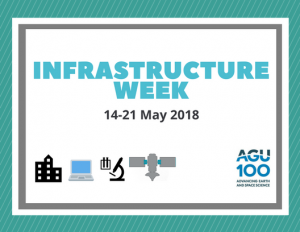May 14, 2018
Infrastructure Helps Us, But Who’s Helping Infrastructure?
Posted by Annika Deurlington
Imagine your (perhaps idealized) morning routine: your alarm goes off, you promptly arise and heat up some breakfast, read the news, shower and brush your teeth, and skip out the door to work. No part of this routine would be nearly so simple without waste and water management systems, telecommunications networks, the electric grid, or roads and public transit. However, it’s easy to overlook the infrastructure that supports our daily lives. Still more invisible, though, are the bodies of research that protect it.
This week, the 6th annual National Infrastructure Week, we will be looking closely at this often-overlooked aspect of life. Every day, new posts on The Bridge will highlight the important role science plays in protecting our nation’s infrastructure and building resiliency.
Science protects infrastructure through old protocols and new knowledge. For example, humans have been determining where to build structures so that they are on stable ground and at a reduced risk from natural hazards for millennia. Research continues to fill in our blind spots, though: An unrecognized landslide unit contributed to the 1928 St. Francis Dam Collapse, and nearly one hundred years later, our ability to identify landslide deposits has substantially evolved such that Washington state is undertaking a LiDAR initiative to map landslides using digital terrain models (DTMs). These DTMs are informing city planners in one of the most landslide-prone states in the country about where to include development setbacks from landslide hazards and what permits to require for every parcel.
Not only does science inform communities where to build structures, science informs communities about what stresses a structure must withstand and how to build resiliency. From earthquakes to heat waves and space weather to extreme storms, scientific information is an essential component to preparedness and minimizing loss of lives and property. As it is, NOAA reported that 2017 was the costliest year on record in the U.S. for damages due to extreme weather events at a whopping $309.5 billion dollars, not including the devastating loss of life our nation suffered.
The infrastructure that helps save us from even greater losses is our “science infrastructure” – the technologies, facilities, and instruments necessary for research. Consider the impacts of extreme weather in 2017 if we hadn’t developed our current water management tools for times of flooding and drought or our forecasting abilities for when there are hurricanes and severe weather. Resiliency for the future stems from our actions today. Thus, when we invest in research projects and their essential tools (like satellites, stream gages, buoys, and supercomputers), we as a nation are investing in the longevity of our infrastructure and the well-being of our communities. This week we’ll be covering the critical science infrastructure that protects lives, property, and livelihoods.
If you have stories of how science is helping protect infrastructure or how science infrastructure is benefiting our nation, share them with us on twitter @AGUSciPolicy using #ScienceInfrastructure. Also, remember to check back in throughout the week to read our next blog posts and share them with your colleagues!


